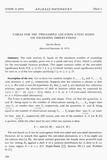Article
Full entry |
 PDF
(1.1 MB)
Feedback
PDF
(1.1 MB)
Feedback
 PDF
(1.1 MB)
Feedback
PDF
(1.1 MB)
Feedback
Summary:
The rank statistic $E$, based on the minimum number of exceeding observations in two samples, gives rise to a quick and easy $E$-test, which is suitable for the two-sample location problem. The paper contains tables of the one-sided significance levels $P\left\{E\geq k\right\}$ for $2\leq k\leq 6$ for sizes $m,n$ of the two samples satisfying $3\leq m\leq n\leq 25$.
References:
[1] T. Haga: A two-sample rank test on location. Ann. Inst. Statist. Math. 11 (1959/60), 211 - 219. DOI 10.1007/BF01682330 | MR 0119315
[2] J. Hájek Z. Šidák: Theory of rank tests. Academia, Prague & Academic Press, New York - London, 1967. MR 0229351
[3] S. Rosenbaum: Tables for a nonparametric test of location. Ann. Math. Statist. 25 (1954), 146-150. DOI 10.1214/aoms/1177728854 | MR 0061314 | Zbl 0056.37602
[4] S. Rosenbaum: On some two-sample non-parametric tests. J. Amer. Statist. Assoc. 60 (1965), 1118-1126. DOI 10.1080/01621459.1965.10480855 | MR 0191050
[5] Z. Šidák S. Hojek: Monte Carlo comparisons of some rank tests optimal for uniform distributions. In Contributions to Statistics - J. Hájek Memorial Volume (in print).
[6] Z. Šidák J. Vondráček: A simple non-parametric test of the difference in location of two populations. (in Czech.) Aplikace matematiky 2 (1957), 215 - 221. MR 0090203
[7] J. W. Tukey: A quick, compact, two-sample test to Duckworth's specifications. Technometrics 1 (1959), 31-48. MR 0106527

